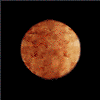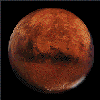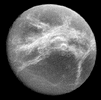 |
|||||
 |
 |
 |
 |
 |
|
Wasteland of Flint
Company briefing for the Ephesus III Delos Expedition
System Data
The Ephesus system is sixty-eight light years from the nearest Earth-controlled world. The primary of the system is a "light" G-class star, about 90% of the luminosity and mass of Sol. There are only four planets, in irregularly-spaced orbits. The rest of the system, apparently, failed to form during star coalescence and a heavy Oort cloud bounds the system. A high incidence of cometary activity has been noted, as well as intermittently heavy bombardment of the planetary surfaces.
The nearest jumpgate is at Nicomedia, which is eleven light years to coreward of Ephesus. For all practical purposes the Ephesus system can only be reached by jump-capable starships.
Planetary Data
| Ephesus I is a small stony planet in close orbit (~1 AU) around the primary. |
 |
| Ephesus II is at ~2 AU and is cloaked in a heavy carbon-monoxide atmosphere with a very high surface temperature. |
 |
| Ephesus III is at ~4 AU and initially drew the attention of a robotic probe due to the disparity between its apparent mass and its surface gravity. Though surface gravity is near 1 G, the mass of the planet is only 86% that of Earth. Further investigation also revealed that the atmosphere contains a rather high level of oxygen despite the lack of any chlorophyll-based vegetation. There is no open water on III, though sub-surface icecaps at the poles have been postulated from the planetary scan data. With care, humans can exist on the surface of III without pressure suits or domed facilities. |
 |
| Ephesus IV is at ~8 AU and may be a captured, or rogue, planet. It is slightly smaller than Ephesus I and there is considerable orbital perturbation, possibly the result of its capture by the gravity well of Ephesus prime. |
 |
Mission Objective
A Company analysis team was flagged to study the probe data for Ephesus III due to the gravity-mass mismatch and the presence of free oxygen in a non-volcanically active, non-chlorophyll bearing biosphere. Their preliminary work indicates that III, at some time in the past, was the target of an extensive terraform operation.
The geological structure on the planetary surface known as the Escarpment, which runs nearly the diameter of the planet, on a diagonal, has been determined to be of an artificial nature. The slot canyons that bisect the Escarpment were identified as being regularly spaced along its length. The reasoning behind the mathematical relationship of the slot canyons, though known (1-3-5-7), has not been matched to any other surface features.
Due to the high possibility of obtaining artifacts from a previously unknown civilization, particularly one capable of large scale planetary reconstruction, the Company has elected to dispatch a Type One Exploration team to Ephesus III. This team has been termed the Delos Mission.
Delos Mission will be based around a Temple-class frontier service vessel, the Palenque. A primary investigation team of seven persons will be deployed to the planetary surface, supported by the eleven person crew of the Palenque, as well as two atmospheric transport shuttles, four ground-cars and four scouting aircraft (Midge-class ultralights). A four person security team will also be attached to the primary investigation team. See attachment A for team composition.
The primary objective of the Delos Mission is to identify and investigate any constructed locations used by the race that terraformed III and to recover any useful artifacts therefrom. Due to the expense of transiting personnel and equipment to the Ephesus system, the safety of the staff and their equipment is first priority.
No military alert flag has been applied to this mission. If, however, a military situation develops, as per directive RPD-216-b, all staff is to evacuate immediately and inform the nearest Naval force and/or base of the event.
Attachment A - Mission Delos Staff
Primary Investigation Team
- Dr. Lewis Clarkson, Xenolinguistics, College of All Saints (Anahuac), Team Lead
- Dr. Molly McCue, Mathematics, Arkham Institute of Technology (Anahuac)
- Dr. Margaret Lennox, Xenoarchaeology, Mars Academy of Sciences (Mars)
- Victor Smalls, PHD Candidate, Meteorology, Mars Academy of Sciences
- Joseph Sinclair, PHD Candidate, Xenobiology, University of Aberdeen (Anahuac)
- Victoria Russovsky, Planetary Geology, University of Aberdeen (Anahuac)
- Vladimir Constantin Tuchachevsky, Physicist, Novo Bialostok Akademy (Novo Rossiya)
Crew of the Palenque
- Captain Xolotl Cardenas
- Executive Officer Toniatuh Cardenas
- Navigator Sigurd Gylfisson
- Ships Mate Alastair Garcia Flores
- Chief Engineer Susan Pātecatl
- Engineers Mate George Mikellson
- Crewman Nicholas Breerson
- Crewman Carson Freeman
- Crewwoman Delores Alonso Flores (engineering)
- Crewwoman Rosanna Alonso Flores
- Supply Officer/Cook Frederick "Frenchy" De'vaques
Palenque Security Team
- Stephen Blake, MDST commander, ex-Marine Lieutenant
- Carlos Fuentes, ex-Marine Corporal
- Antonio Fuentes, ex-Marine Corporal
- Nichole Steward, ex-Navy Petty Officer-Electronics
Mission Kyklades Staff
Relief Team
- Gretchen Anderssen, forensic xenoarchaeology, University of New Aberdeen (New Aberdeen)
- Magdalena, Hesht national, communications officer
- David Parker, Company pilot
- Dai Bandao, Company security officer
Crew of the Cornuelle (IMN CL-341, Astronomer Class)
- Chu-sa (Commander, captain) Mitsuharu Hadeishi, Imperial Navy (New Yedo, Anahuac)
- Sho-sa (Lieutenant Commander, executive officer) Susan Kosho, Imperial Navy (Usonomiya City, Anahuac)
- Thai-i (Senior Lieutenant, weapons officer) Patrick Hayes, Imperial Navy (Kingston, Lower Scotland, Anahuac)
- Thai-i (Senior Lieutenant, engineering) Isoroku Oushi, Imperial Navy (Churgangrad, Novoya Rossiya)
- Sho-i Ko-hosei (Midshipman, communications) Daniel Smith, Imperial Navy (Europa Planita Dome Six, Mars)
- Gunso (Sergeant) Dylan "Hork" Fitzsimmons, Imperial Marines (Hohokam, Anahuac)
- Heicho (Corporal) Harrison Deckard, Imperial Marines (Popol Vuh, Anahuac)
- Heicho (Corporal) Tanuac, Imperial Marines (Cholua, Anahuac)
- Captain's Steward Kusaru Yejin, Imperial Navy (New Yedo, Anahuac).
Company Briefing Notes for the Ephesus III Kyklades Mission
Current Status
All communications by tachyon relay with the Delos Mission have been in abeyance for the past sixteen standard Earth days. Up to that time, all status reports had been submitted regularly to RWV control in this sector. No indications of problems in the excavations or aboard the Palenque had been reported.
By the same token, the Delos team had made no discoveries of unexpected note, either. Ephesus III remained a dead, though interesting, world. The only interesting item of a scientific nature had been a report from Victor Smalls that the level of O2 in the immediate area of the primary camp (at slot canyon 432) had been steadily rising since the arrival of the primary team. The supposition of the primary team is that there is some function of the planetary biosphere that converts CO2 into C and O2. This mechanism had not been identified as yet.
The Company posits that the most likely incident to cause the loss of communications between the team and the sector base is either (a) a mechanical failure aboard the Palenque, or (b) the sudden outbreak of a fatal or debilitating disease amongst the crew and/or ground teams.
Discussions with the Navy have yielded no indication that there is pirate activity in the sector, so this cause of the communications outage is rated a very low probability.
Mission Objective
The discovery of evidence that Ephesus III was, in fact, occupied by an advanced technological race in the 1-2 million year (Anahuac Standard) timeframe has promoted the deployment of a supplemental investigation team to Ephesus.
This team is now termed Kyklades team.
The objectives of Kyklades team are threefold:
- Restore communications between Palenque and sector control. Render any aid necessary to the primary team.
- Expand the area of investigation being covered by Delos team with emphasis on the number three "Engineer" ruins site, indicated as "The Observatory" on the maps supplied by Dr. McCue.
- Investigate and determine the mechanism responsible for the O2 level rise in the primary camp area.
The Navy Astronomer-class light cruiser Henry L. Cornuelle, Chu-sa Mitsuharu Hadeishi commanding, which will be making a sweep through the sector on standard patrol, will provide transport to the Ephesus system. Space aboard the Cornuelle is limited, so the secondary team will be limited to those items that can be carried on their person, or in a standard 1m × 1m cargo cube. Repair parts for the tachyon relay aboard the Palenque comprise the remainder of your equipment.
The Cornuelle will depart sector control in three standard (Anahuac) days. Further arrangements with the Navy should be made through the officers of the Cornuelle's XO, sho-sa Susan Kosho.